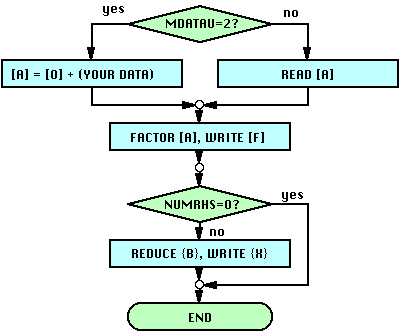PURPOSE
Factor a matrix into triangular form. Optionally perform forward reduction (and diagonal scaling) on right-hand side vectors.SYNOPSIS
CALL RSDF (LUA, LUF, LUB, LUX, NUMRHS)
CALL RNDF (LUA, LUF, LUB, LUX, NUMRHS)
CALL CHDF (LUA, LUF, LUB, LUX, NUMRHS)
CALL CSDF (LUA, LUF, LUB, LUX, NUMRHS)
CALL CNDF (LUA, LUF, LUB, LUX, NUMRHS)
INPUT PARAMETERS
- LUA(25) = Integer Array.
File attributes for matrix [A]. - LUF(25) = Integer array.
File attributes for the file where the matrix factors are to be written. These file attributes are usually the same as LUA to overlay the factored matrix on the original matrix to conserve space. If the original matrix is to be preserved, the FMSOM subroutine should be called to open the files for storing the matrix factors and create the LUF attribute list. - LUB(25) = Integer array.
File attributes for right-hand side vectors. If no forward reduction is performed during factoring, a dummy argument should be specified. - LUX(25) = Integer array.
File attributes for the file where reduced vectors are to be written. This parameter is usually the same as LUB to overlay reduced vectors on the original right-hand side vectors. If no forward reduction is performed during factoring, a dummy argument should be specified. - NUMRHS = Integer.
Number of right-hand side vectors to reduce during the factoring process. If NUMRHS is specified zero, no forward reduction (and diagonal scaling for symmetric matrices) is performed during factoring.
OUTPUT PARAMETERS:
None.FMS PARAMETERS:
The following FMS Parameters are especially important to this routine:| Parameter | Description |
|---|---|
| Input Parameters | |
| IPRF | Factoring print code |
| IPRS | Solution print code |
| MDATAU | Call your subroutine to define or modify matrix data |
| NEQSUB | First equation of substructure |
| MPOSDF | Positive definite flag |
| MZERO | Zero pivot flag |
| NBITSZ | Number of lost bits on diagonal to call zero |
| NBITSP | Number of lost bits on diagonal to print a warning |
| RPIVOT | Value to set zero pivot reciprocal |
| PIVMIN | Absolute value of minimum pivot |
| IALGOR | Optional factoring algorithms |
| MINDIM | Minimum dimension to terminate Strassen's algorithm |
| IPOLLD | CPU synchronization on diagonal elements |
| Output Parameters | |
| NUMSCG | Number of diagonal sign changes during factoring |
| NPIVOT | Number of equations pivoted (SLAB format) |
| CONINV | Inverse condition number |
| ATERMS | Number of terms in matrix |
| AZEROS | Number of zero's in matrix |
| FZEROS | Number of zero's in matrix factor |
| SAVOPS | Number of floating point operations saved |
DESCRIPTION:

This subroutine performs the following steps:
-
Obtain [A]
If the FMS parameter MDATAU is 2, the matrix data is obtained by initializing [A] to [0] and calling one or more of the subroutines you provided to define the matrix data:
If MDATAU has any value other than 2, the matrix is read from file LUA and your subroutine(s) are not called.Matrix Format Data Type Matrix Symmetry Subroutines Required PROFLIE or BLOCK Real Symmetric RSUBLK PROFLIE or BLOCK Real Nonsymmetric RSUBLK, RNUBLK PROFLIE or BLOCK Complex Hermitian CHUBLK PROFLIE or BLOCK Complex Symmetric CSUBLK PROFLIE or BLOCK Complex Nonsymmetric CSUBLK, CNUBLK SLAB Real Nonsymmetric RNUSLB SLAB Complex Nonsymmetric CNUSLB -
Factor [A]
The completed matrix [A] is then factored into one of the following forms:[L][D][L]T = [A] for symmetric [A]
or
[L][U] = [A] for nonsymmetric [A].
Here, [L] is a lower triangular matrix with Lii = 1 and Lij = 0 for i<j. The matrix [D] is diagonal with Dij = 0 for i not equal to j. The upper triangular matrix [U] has nonzero values on and above the diagonal with Uij = 0 for i>j. The symbol "T" is used to denote the transpose for symmetric problems.
-
Write the factored matrix to file LUF.
FMS writes the matrix factors to the file you provide described by the attributes LUF. You may overwrite the matrix factors on the input matrix file LUA by specifying the same file attributes for LUF that you specified for LUA. -
Reduce {B}
If you specified NUMRHS>0, FMS performs forward reduction (and diagonal scaling for symmetric problems) on the vectors in file LUB. This option saves reading the matrix factor [L] at the expense of rereading the right-hand side vectors {B} several times. If the number of solution vectors is small, or the solution vectors are in memory, this option should be used. However, if there are a large number of disk-based solution vectors, forward reduction should be performed using the solution subroutines RSDS, RNDS, CHDS, CSDS, CNDS. To skip this option, specify a zero value for NUMRHS and dummy arguments for LUB and LUX.
CALL RSDAF (LUA,1.0D0,NUMAI,IDUM,0,0,LUF,LUB,LUX,NUMRHS)
CALL RNDAF (LUA,1.0D0,NUMAI,IDUM,0,0,LUF,LUB,LUX,NUMRHS)
CALL CHDAF (LUA,1.0D0,NUMAI,IDUM,0,0,LUF,LUB,LUX,NUMRHS)
CALL CSDAF (LUA,1.0D0,NUMAI,IDUM,0,0,LUF,LUB,LUX,NUMRHS)
CALL CNDAF (LUA,1.0D0,NUMAI,IDUM,0,0,LUF,LUB,LUX,NUMRHS)
where IDUM is a dummy argument. The value of NUMAI is 0 if
MDATAU = 2. Otherwise, NUMAI is 1. If you want to perform
matrix factoring as a separate step, you may use this
subroutine. Otherwise, you should use the more general
assemble-factor subroutine.